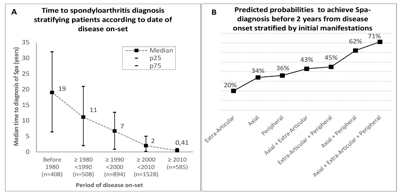Session Information
Session Type: ACR Poster Session C
Session Time: 9:00AM-11:00AM
Background/Purpose: Diagnostic delay is one of the greatest challenges in Spondyloarthritis (SpA).
Methods: We designed a cross-sectional study, including adult patients fulfilling ASAS SpA criteria from a multicentric international study for the ASAS-COMOSPA study. We evaluate trends in time to diagnosis of SpA during last decades, and its association with 2009 ASAS SpA classification criteria and clinical presentation. Disease onset was defined as first SpA-related musculoskeletal manifestation and/or diagnosis of extraarticular disease [uveitis, inflammatory bowel diseases (IBD) or psoriasis]. In those patients who developed an isolate extraarticular disease as initial manifestation, we performed a secondary analysis defining disease onset at first musculoskeletal manifestations. Time to diagnosis was defined as the gap between SpA diagnosis and disease onset. We stratified patients according decade of disease onset and initial clinical presentation and developed a multivariate logistic model, using early diagnosis (<2 years) as dependent variable and decade of disease onset, initial clinical presentation, sacroiliitis on x-ray, sex and age at disease onset, as independent variables. We estimated predicted probabilities for different clinical presentations.
Results: We included 3984 patients. Median time to diagnosis was 2.9 (p25-75= 0.3 Ð 9.8) years. This delay in diagnosis showed a progressive decrease during last decades (Graph 1A). Patients with disease onset after 2010, showed a shorter delay in diagnosis than those with disease onset in 2000-2010 decade. More frequent clinical presentations at disease onset were: isolated axial involvement (46%), isolated peripheral disease (20%), isolated extra-articular disease (19%), and multiple manifestations (15%). According to multivariate analysis, the probability to have an early diagnosis increased from 8% in patients before 1980 to 67% after 2010. Initial clinical presentation were independent predictors of time to diagnosis (Graph 1B).
Conclusion: Recognition and diagnosis of SpA have improved during the last decades. Type and number of initial clinical presentation were independent predictors of time to diagnosis.
Graph 1A-1B.
To cite this abstract in AMA style:
Perez-Alamino R, Maldonado Ficco H, Waimann CA, Maldonado-Cocco JA, Moltó A, Dougados M, van der Heijde D, Landewé RBM, van Den Bosch F. Trends in Time to Diagnosis in Spondyloarthritis Patients. Association with 2009 ASAS Classification Criteria and Clinical Presentation at Disease Onset. Data from Comospa Study [abstract]. Arthritis Rheumatol. 2017; 69 (suppl 10). https://acrabstracts.org/abstract/trends-in-time-to-diagnosis-in-spondyloarthritis-patients-association-with-2009-asas-classification-criteria-and-clinical-presentation-at-disease-onset-data-from-comospa-study/. Accessed .« Back to 2017 ACR/ARHP Annual Meeting
ACR Meeting Abstracts - https://acrabstracts.org/abstract/trends-in-time-to-diagnosis-in-spondyloarthritis-patients-association-with-2009-asas-classification-criteria-and-clinical-presentation-at-disease-onset-data-from-comospa-study/

